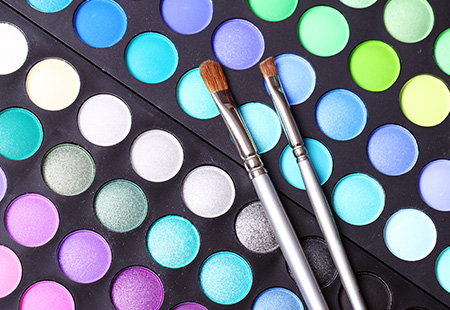One of the world’s most lucrative industries is the beauty and cosmetics business. The global worth of this colossal market was estimated at $500 billion in 2020, with Statistica predicting that figure to reach $758 billion by 2025. However, despite sayings such as ‘beauty is pain’ and ‘no pain, no gain,’ no one expects their makeup to contain a deadly, and easily inhalable substance, yet this is the growing concern facing the industry and its consumers; asbestos contamination in makeup products.
  |   |   |
!
 Si es posible que haya estado expuesto al asbesto, hable con su proveedor de atención médica sobre pruebas y exámenes para ayudar a detectar la presencia de fibras de enfermedades relacionadas con el asbesto.
Si es posible que haya estado expuesto al asbesto, hable con su proveedor de atención médica sobre pruebas y exámenes para ayudar a detectar la presencia de fibras de enfermedades relacionadas con el asbesto.
The Claire’s and Justice Scare
Since 2017, almost a dozen makeup products marketed to children have been recalled and pulled from the shelves due to concerning reports of asbestos contamination. Alarmingly, a big part of the problem is that the cosmetics industry is essentially free to police itself; lawmakers are now increasingly pushing for changes to these regulations or lack thereof.
In 2017, an independent lab detected asbestos in several cosmetics that were being marketed towards teens. In March 2019, the FDA confirmed that cosmetic products from retailers Claire’s and Justice were both found to contain asbestos, triggering justifiable fear in hearts and minds of their customers and parents of the brand’s users.
“La evidencia general sugiere que no existe un nivel seguro de exposición al asbesto”.Fuente: Instituto Nacional del Cáncer (NIH)1 |
The Talc Connection
Asbestos exposure is well-known to have dangerous health effects, and manufacturers of beauty and cosmetic products do not intentionally include it in their makeup production. However, talc is commonly used, and this is where the issues arise. When talc is mined, traces of asbestos can essentially hitch a ride.
Talcum powder used in cosmetics might be contaminated with asbestos if it comes from an unclean source. Asbestos and talc often coexist naturally in the ground, and it is not uncommon for talc to become contaminated with asbestos fibers as it is being mined.
Talcum powder is in some cases contaminated with asbestos fibers, and has even been associated with ovarian cancer.
Makeup, baby powder, and other personal care items that use talc are required to use only cosmetic-grade talc, which is talc that has been refined to remove any traces of the hazardous mineral. Unfortunately, however, the federal government does not strictly regulate the talc industry to guarantee that it is asbestos-free, causing a mammoth gray zone in which many asbestos-containing beauty products enter the market, sometimes without the manufacturer even knowing it’s there.
The Environmental Working Group estimates that more than 2,100 commercially available goods include talc. With these goods spanning everything from newborn and baby powders to a wide variety of eye shadows, face powders, blushes, and other cosmetics, there is certainly cause for alarm. The biggest danger comes from items that are fine or loose enough to become airborne and subsequently inhaled – and with so many of these products being powder-based, engaging involuntarily in a game of Russian Roulette with your health when using beauty products is all too real.
“Por lo general, quienes desarrollan enfermedades relacionadas con el asbesto no muestran signos de enfermedad durante mucho tiempo después de la exposición”.Fuente: Instituto Nacional del Cáncer (NIH)2 |
The lack of regulations on asbestos in makeup
In the United States, using talc that may contain asbestos is not prohibited by law. It would seem relatively likely, then, that regular users of talc-based cosmetics would come into contact or proximity with asbestos fibers at some point. Those working in factories that make talc products must be especially cautious of the dangers and take the necessary steps to protect themselves from this elevated risk.
The possibility that Johnson & Johnson’s (J&J) talcum powder contains cancer-causing asbestos has also been the subject of extensive litigation. In the 1970s, when talc powder was still widely used, the organization was even found to have injected inmates with asbestos to test its effects on the skin.


Talc and ovarian cancer
While some research points to the possibility of asbestos fibers traveling to the female reproductive system via the bloodstream or lymphatic system, the jury is still out as to exactly how asbestos-related epithelial ovarian cancer occurs.
Some experts and researchers have speculated that asbestos-containing talcum powder was once commonly applied to the genital area after having a bath or shower, and that the fibers may have migrated from there to the ovaries. Inhalation is another possible route of exposure to asbestos in talc.
In any case, talc crystals and asbestos were found in ovarian tissues in a 2021 investigation, and several studies have uncovered a direct link between ovarian cancer and the application of talc to the perineal region.
In order to better understand the link between genital, asbestos-containing talc use and cancer, Harvard researchers undertook a retrospective study across 2,041 recorded cases of epithelial ovarian cancer. The study found that the risks of developing epithelial ovarian cancer as a result of genital talc use differed depending on a range of factors, such as menopausal status, weight, smoking habits, hormone treatments, and more. The study also concluded that the use of estrogen and/or prolactin treatments could contribute to any inflammatory reaction caused by the talc.
“[S]ome [asbestos] fibers may bypass…your body’s natural defenses…and lodge deep within your lungs. Those fibers can remain in place for a very long time and may never be removed.”Fuente: Asociación Americana del Pulmón |
How to know if your makeup contains asbestos
You deserve to have the peace of mind that you are safe when applying makeup or using other cosmetics. To determine if your makeup products contain asbestos, there are some steps you can take, including:
- Identifying and avoiding the makeup brands that have asbestos
- Using only talc-free cosmetics products
- Asbestos testing – this is a more costly exercise, but if you really want to be sure of a particular product, you can determine whether it contains asbestos by purchasing an asbestos sample test kit online
Of course, the easiest solution is to spend some time researching brands that are talc-free and asbestos-free. Popular talc-free brands include Pacifica, Shea Moisture, Honest Beauty, Everyday Minerals, and Ecco Bella.
Additionally, products from China, one of the world’s greatest exporters, should be carefully reviewed. While the vast majority of Chinese imports are risk-free, a concerning number of items tested positive for asbestos, including makeup, talcum-based products, children’s toys, and more. When determining whether a product is safe, consider the origins of its manufacture as a part of your research.
¿Califica usted para una compensación?
Descubra rápida y fácilmente cómo estuvo expuesto buscando en WARD, la base de datos de asbesto más grande del planeta.
BÚSQUEDA GRATUITA >Does mica have asbestos in it?
One safer alternative to talc is mica. Mica is also a naturally occurring mineral and is most commonly added to cosmetics as a shimmering agent. Unlike talc, however, mica is not known to have any issues with asbestos contamination, so it’s certainly a safer choice for anyone concerned about asbestos in their makeup. That said, it’s important to note that mica mining does prompt debate around its negative environmental and social impacts, so take the time to ensure that your consumer choices, including makeup brands, are aligned with your values.
Protect yourself until the lawmakers step up
Asbestos contamination in beauty products is a rising worry for consumers, and the lack of federal standards in the cosmetics industry enhances the problem significantly. Until more is done from a legislative perspective, consumers should learn about the risks and take steps to protect themselves from exposure, such as by switching to talc-free brands.
AsbestosClaims.Law
Para Justinian C. Lane, obtener una indemnización por las víctimas del asbesto es algo personal.
Los abuelos de Justiniano y su padre trabajaron con asbesto en su juventud y murieron de cánceres relacionados con el asbesto en sus últimos años.
En el momento de cada una de sus muertes, nadie en la familia de Justiniano sabía que eran elegibles para presentar una demanda por asbesto y buscar una compensación de los fideicomisos de asbesto.
Debido a que nadie en la familia de Justiniano conocía sus opciones, nunca recibieron compensación alguna por la muerte de sus seres queridos.
Si cree que su lesión o la de su familiar estuvo relacionada con la exposición al asbesto, podría tener derecho a una compensación significativa.
Este es dinero que podría usar para cubrir los costos de los servicios de remoción de asbesto, pagar el tratamiento médico y proteger de manera preventiva su bienestar físico.
También hay fideicomisos de asbesto que ofrecen compensación mucho más rápida y fácilmente (sin presentar una demanda).
Si desea ayuda para presentar un reclamo, ponerse en contacto por correo electrónico a [email protected] o llámenos o envíenos un mensaje de texto al (833) 4-ASBESTOS (427-2378) o (206) 455-9190. Escucharemos su historia y le explicaremos sus opciones. Y nunca cobramos por nada a menos que reciba dinero en su bolsillo.
Además de demandas legales, discapacidad de veteranos, seguridad social y protección del empleo como compensación de trabajadores, FELA y La ley de Jones para los trabajadores marítimos, hay fideicomisos de asbesto que se han establecido para indemnizar a los perjudicados por el asbesto sin tener que presentar una demanda.
No hay riesgo ni costo para hablar con uno de nuestro personal sobre su litigio de asbesto. No hay cargos a menos que reciba dinero.
Si tiene preguntas o inquietudes adicionales relacionadas con el asbesto, visite nuestro sitio web y página de YouTube para ver videos, infografías y respuestas a sus preguntas sobre el asbesto, incluida la salud y la seguridad, prueba de asbesto, la eliminación del asbesto de su hogar y edificio, y información legal sobre la compensación por lesiones de asbesto.
Presentamos la base de datos de información sobre asbesto más grande del planeta.
W.A.R.D., que significa Worldwide Asbestos Research Database, ayuda a los clientes a reducir cuándo y dónde pueden haber estado expuestos, así como qué productos aún pueden contener asbesto.WARD también ayudará a indicar los tipos de compensación ya cuánto puede tener derecho una persona.
1 Instituto Nacional del Cáncer (NIH) Hoja informativa sobre asbesto.
2 Instituto Nacional del Cáncer (NIH), Hoja informativa sobre asbesto.




